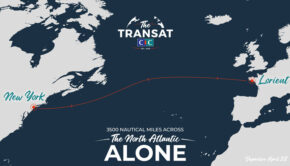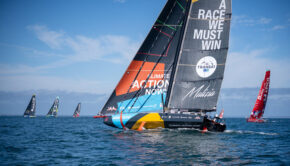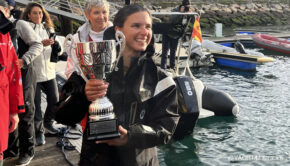What’s behind the design of Hugo Boss?
Published on January 9th, 2017
While leading the Vendée Globe on Day 14, Alex Thomson’s IMOCA 60 Hugo Boss hit a submerged object in the South Atlantic, obliterating the foil on his starboard side that helped to reduce displacement while on port tack.
After slipping over 800 nautical miles off the lead while crossing the Indian Ocean, a stretch where he was primarily on port tack, Thomson ascent up the Atlantic now has him threatening for the lead on Day 65.
In this report for Yachting World, James Boyd looks under the hood at what may be Thomson’s better boat.
The 2016/7 Vendée Globe race will go down as one dominated by two very different sailors, Frenchman Armel Le Cléac’h and Briton Alex Thomson in two critically different yachts.
There is no doubt that Thomson’s foil-borne Hugo Boss is very fast in perhaps a wider range of downwind conditions, and development of this foiling technology will be at the forefront of designers’ minds as they work towards designs for the next monohull round the world races.
But what exactly are the key features of Thomson’s black boat, and how does it work?
For the design of Hugo Boss, Thomson and his team chose the race-winning partnership of VPLP and Guillaume Verdier, who have all but cornered the market in new IMOCA 60 designs.
Like the five other new VPLP-Verdier designs, Hugo Boss is a semi-foiler, with giant and – frankly in her case – quite sinister-looking appendages protruding from either side that have been compared to ‘Dali’s moustache’ in the French press.
Watch this video of Alex Thomson Racing CEO showing and explaining Hugo Boss’s foils.
The complex shape of these boards is because, just like on modern foiling catamarans, they must perform a dual role: their vertical surface creates lateral resistance to prevent leeway, while their horizontal surface provides upward lift beneath the hull, reducing wetted surface area and lift to leeward thereby increasing righting moment and stability.
The result is a boat that does frequently ‘show keel’ and daylight beneath her hull an impressively long way aft and, in Hugo Boss’s case, in impressively little wind (ie with full main still hoisted). However, weighing around 7.5 tonnes and with no lifting surfaces on her rudders, she is no 60ft Moth.
Nonetheless, just as is the case currently with the foiling multihulls, this development does represent one of the most significant performance boosts ever seen in monohull design.
While other IMOCA foil-equipped yachts that started the same race, Safran, Banque Populaire and No Way Back, are the MkI of the new VPLP-Verdier designs and Edmond de Rothschild and St Michel-Virbac are MkII, Thomson refers to Hugo Boss as MkIII. She certainly has many differences from the others, most noticeably her giant foredeck chamfer.
To watch dramatic aerial footage of Edmond de Rothschild semi-foiling IMOCA 60…click here.
According to Thomson, Hugo Boss is also the narrowest of the new boats. “We made a call quite early on that the foils would work. If the foils are working and creating stability and lift then why do you need to have such a wide boat?” A narrower boat is also lighter, with less wetted area and lower drag, he argues. – Full report









 We’ll keep your information safe.
We’ll keep your information safe.